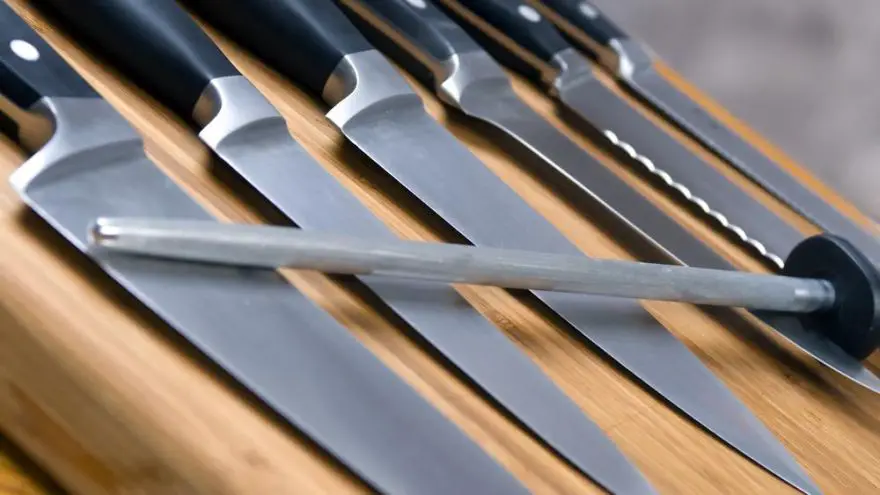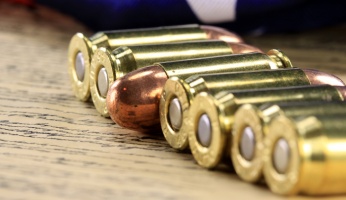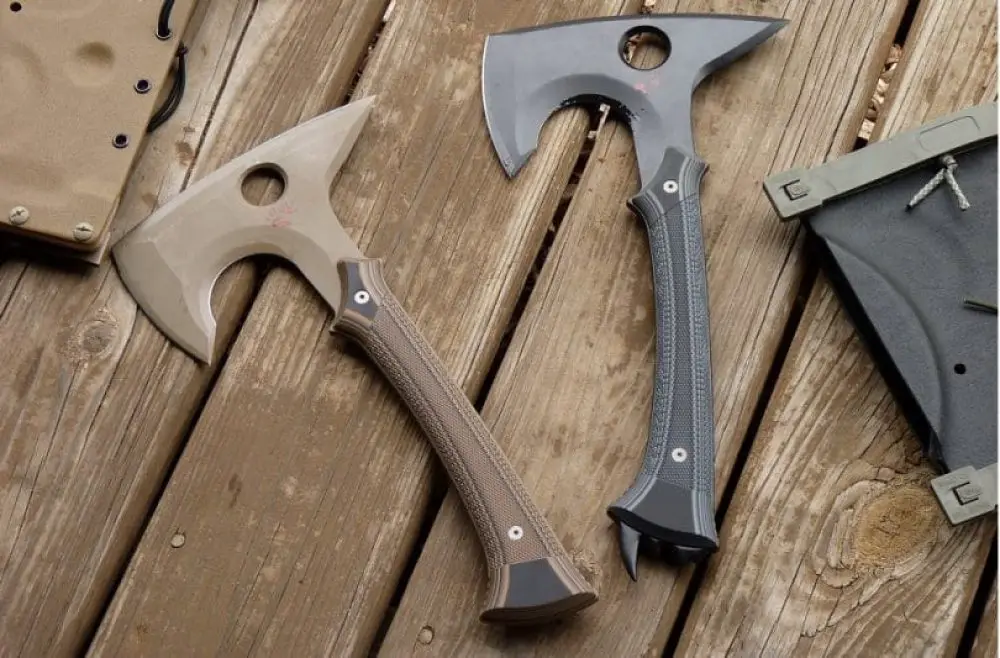How to Sharpen a Knife: The Complete Guide
 How to Sharpen a Knife: The Complete Guide
thegearhunt.com
How to Sharpen a Knife: The Complete Guide
thegearhunt.com
Cutting any objects with a dull knife can be a long and frustrating task. When your knife is dull it will cause you to use more force in order to get the job done. Making sure your knife is sharp will cause less damage to the object or material you are working with.
You may not have noticed that when you get a new knife, it isn’t razor sharp. Sure it is sharp, but achieving the kind of sharpness that will allow you to shave the hair off your arm can’t be done mechanically. Most knife sets are produced and sharpened in a machine shop. Getting that extremely sharp edge needs to be done manually and can sometimes take a ton of effort.
There is a simple test that anyone can perform to test how sharp their knife truly is. Using a single sheet of paper, hold your knife to the edge. Cut down using an outward motion, if your knife goes through the paper smoothly, then your knife is sharp. In the event that it goes through the paper but is met with some resistance, then it is probably time to provide your knife with a little pampering.
There are many methods for sharpening your knife, as well as gadgets and sharpeners on the market to better assist you in sharpening your knives. Many old timers will tell you that you really don’t need all the bells and whistles to sharpen the blade of your knife. One of the most important factors to sharpening your blade is remembering to keep the existing angle on the blade. Once you have mastered the technique for holding the angle, the rest will come easy.
This guide was developed to teach you some techniques for sharpening your blade. As well as some of the equipment on the market today for sharpening your knives. After reading this you should have a better understanding of what is best when it comes to knife sharpening.
Steel Rods: We have all seen these included with our new knife sets, but do you know what the intended use for one of these really is? What I will tell you is that it isn’t for sharpening your blade. These steel rods instead are intended to hone or fix the edge of your blade when it gets out of whack.

- Directions for Using a Steel Rod
For safety purposes, hold the rod with the end secured down on the countertop. Place the fatter end of the blade against the rod, the tip of the knife should be slightly raised. All the while keeping the blade away from the steel at an angle relatively close to 15 degrees. - Using a light amount of pressure combined with maintaining the angle of the blade, create a sweep style motion, which will allow you to move the blade down the rod.
- During your sweeping motion, the middle portion of the blade should slide along the middle section of the rod. To make sure that this happens, be sure your moving the knife in toward your body.
- Repeat this process, alternating sides of the blade, for roughly 5 passes per side of the blade. That should be plenty to repair the edge of your blade.
Knife Sharpeners: When using your steel rods to touch up the edge of your blade doesn’t seem to help, the next best thing you can do is try a sharpener. Your blade made need a bigger amount of metal taken off of it in order to repair it. This can be done one of three ways, one of which would be to send the knife to a professional. Although this can be costly for some it is the best-suited option. The more traditional way to sharpen your knife is with a whetstone, this type takes tons and tons of practice. Your third option is to use either an electric sharpener or manual one. This is normally the quickest and easiest option for those with less experience.
Electric Sharpeners: These are one of the simplest pieces of equipment to use for sharpening a knife. The first slot to these is normally the one you would use for more aggressive treatment to the blade. This option, depending on the model you choose, can become rather pricey for some users.

Directions for Using an Electric Sharpener
- First, let me start by saying it is always best to read the directions from the manufacturer before using the product.
- Obviously, you will want to start by turning on the sharpener. Next, select the slot you will need in order to repair your knife.
- Holding the knife securely, run the knife through the slot you have chosen to use, you really don’t need to hold your knife down very hard. After all, the point to these sharpeners is to let them do the hard part for you.
- Be sure to rotate sides, this will allow for both sides of the blade to be sharpened. Keep in mind that you want to move the blade slowly through the machine careful not to make the blade jerk. This could potentially cause knicks to the blade, therefore defeating your intentions.
Manual Sharpeners: These are essentially made to achieve the same effect as their counterpart, the electric sharpener. The difference between the two is that the electric sharpener has the gritty material on motorized wheels. The manual sharpener has the gritty material mounted to a chamber that is typically shaped in a V. These are also known for being less expensive, but can’t fix the more extensive damage that can happen to the blade of your knife.
Tips for Using a Manual Sharpener
- The theory behind the technology is the same as that of the electric sharpener.
- With the manual sharpener, the person holding the blade will perform the work. Be sure to use even pressure and strokes when running the blade through the sharpener.
- Make sure to refer to the operating manual for full directions for using the manual sharpener you have purchased.
Whetstones: This form of sharpening takes a lot of practice in order to make sure you are sharpening your blade properly. It is highly recommended that you pick up a cheap kitchen knife to get some practice in before using this technique on a more costly knife. With a whetstone, you need to be sure that you are holding the knife true to the angle that already exists on the blade. One fact to keep in mind when using a whetstone for sharpening, apply light pressure, making sure your pressure is even during your strokes.

- Directions for Using a Whetstone
Before starting this process, make sure you have secured your whetstone to the surface of your countertop or table you will be working on. This can be done by placing a damp rag under the whetstone, which will help reduce sliding. - With the blade of the knife pointing away from you, put the knife on the whetstone, as close to the handle that you can get it. Hold the knife according to the the angle of the edge of the blade, angles are typically between 15-20 degrees. Using your free hand to hold the middle section of the blade, make sure to keep your fingers behind the edge of the blade, move your knife down the stone in a wide circle pattern. Depending on how dull your knife is you may need to repeat this process several times.
- You will need to repeat step three on the opposing side of the blade. A good rule of thumb is to perform the same number of strokes on each side of the blade. After completing the second side, you can now check the sharpness of the knife by doing the paper test we covered earlier in the guide. If the knife is to your level of sharpness you are finished. If not, repeat the process again until the desired sharpness is met.
Hacks for Making Your Own Knife Sharpener

Before all the fancy gadgets came into play, people had to come up with their own ways in order to sharpen their knives. Over time these hacks have long since been forgotten, with a little research, I have been able to resurrect a few methods for those who may need ideas in a pinch.
Using an old mouse pad combined with sandpaper: Using an old rubber backed mouse pad with a sheet of sandpaper secure to it, you can achieve sharpening your blade. You will want to use a fine paper for just touching up the blade, for more extensive work on a blade use a coarse grain first then finish up with the fine paper. All you need to do is hold the knife blade slightly angled against the sandpaper. Then make slow and even stroke across the paper, making sure to include the tip of your blade. Do this to both sides of your blade until the desired level of sharpness is met. Note: If you don’t have these to items available, you can most definitely use an emery-board as well.
Ceramic dishes: If you have a set of ceramic dishes, such as coffee mugs or bowls, flip one over to see if it has a ring of uncoated ceramic. If so you’re in luck, that uncoated portion of the ceramic can be used much like the stones to sharpen your blade. Just be sure to hold the blade according to the angle, and used the circular motion that you would while using a stone.
Smooth Stones: A smooth stone can replace your sharpening stone in a pinch. Just make sure that the stone you choose has at least one flat and smooth surface to work with. A perfect place to find such stones is near the river, after you have your stone, just sharpen your knife as you would normally do with your sharpening stone.
Concrete: This is not always the best alternative, but can be used when needed. Just make sure if you’re going to attempt this option, that the concrete patch you intend to use is completely smooth. Once you have found a smooth concrete surface, use this surface as you would your sharpening stone.
Taking Your Knives in to be Sharpened: There is one last option for sharpening your knives, that is to take them somewhere to be professionally sharpened. This option can have many benefits to the lifetime of your knife. People who sharpen knives for a living normally have years of experience handling and sharpening knives. This allows them to sharpen your blade properly without causing any damage to your blade. You can always use this option for blades that have more extensive damage that you can’t handle on your own after all these knife sharpeners have machines to assist them with caring for your blade. You will have to check within your area to find a professional knife sharpener, but some big name sporting-good stores should be able to assist you with sharpening your knives.
In closing, knife sharpening on your own when done properly can save you both time and money. Be sure to take care in the area of safety during sharpening, doing things in a rush can cause unnecessary injuries. In the event you have never sharpened your own knives before, you may want to consider picking up a cheap set for practice.
You have several options to choose from when it comes to sharpening your own knives, only you can pick which option works best for you. Look to your surroundings when in a bind, you never know what might be laying around that could prove resourceful for sharpening your knife.
Sources
- www.spruce.com, How to Sharpen a Knife With a Whetstone
- www.gizmodo.com, How to Sharpen Any Knife
- www.cooksillustrated.com, How to Sharpen Kitchen Knives
- www.knife-depot.com, 10 Everyday Objects You Can Use to Sharpen a Knife















